 Photographs
taken by photographer Jack Guez show tunnels dug by Hamas from Gaza into
Israel. IDF troops still occupied with uncovering and destroying more
tunnels: ‘Every day of combat allows us to inflict greater damage on
this infrastructure.’
Photographs
taken by photographer Jack Guez show tunnels dug by Hamas from Gaza into
Israel. IDF troops still occupied with uncovering and destroying more
tunnels: ‘Every day of combat allows us to inflict greater damage on
this infrastructure.’
Itay Blumenthal
|
Underground Gaza – An insider’s look at the enormous strategic threat posed by Gaza:
A series of photos captured by photographer Jack Guez on Friday reveal a
tunnel dug from the Gaza Strip into Israeli territory, exiting near a
community.
The photographs illustrates the threat in full force – the tunnels are professionally constructed, some reinforced with cement, equipped with rail tracks, power cables and a communications system. Hamas has invested a fortune in building the tunnels meant for terrorist attacks.
The photographs illustrates the threat in full force – the tunnels are professionally constructed, some reinforced with cement, equipped with rail tracks, power cables and a communications system. Hamas has invested a fortune in building the tunnels meant for terrorist attacks.
 An Israeli army officer gives explanations to journalists during an army organised tour in a tunnel (Photo: Reuters)
An Israeli army officer gives explanations to journalists during an army organised tour in a tunnel (Photo: Reuters)The IDF Spokesperson’s Unit announced on Friday that since the ground operation was first launched, IDF troops have uncovered 31 tunnels, 11 of which that were destroyed and taken out of use. Earlier, GOC Southern Command Maj.-Gen. Sami Turgeman held a press briefing and addressed the threat posed by the tunnels.
“We have been working steadfastly since the moment we entered the
Gaza Strip to locate and destroy the tunnels. We were able to uncover
and demolish at least half of the enemy's tunnels used for attacks and
we are continuing to work with determination."
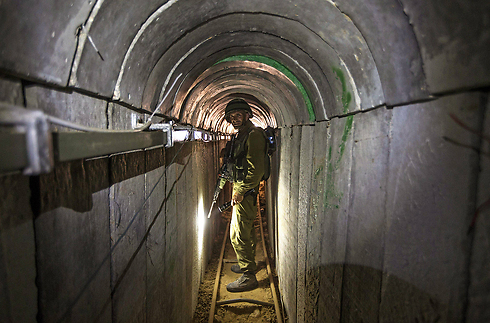
Photo: Associated Press
"Hamas has been building underground infrastructure for years. There's an underground Gaza – this isn't a slogan, but rather the plain truth. Our units have come across it and in every day of our combat we manage to damage this infrastructure.
He stressed that "It took the movement five years to build the
tunnels, some of the tunnels took four years to build, and we managed,
in one week, to cause significant damage to this capability. I believe
that every day of combat will allow us to deliver a fatal blow to what
Hamas considers an important infrastructure."

Israeli army officers talk at the entrance of a tunnel (Photo: Reuters)
In general, the tunnel issue is defined in Gaza as a national flagship project. It includes three types of tunnels: The smuggling tunnels on the Philadelphi Route in Rafah, the offensive tunnels along the border fence with Israel, and the strategic tunnels inside the Gaza Strip which are meant to be used mainly for mobilizing forces between areas at times of emergency, but also for firing rockets, mine laying and kidnapping.
The cost of each tunnel, some of which extend over hundreds of
meters, is huge. There are hundreds of people in the Strip whose only
purpose in life is to dig.
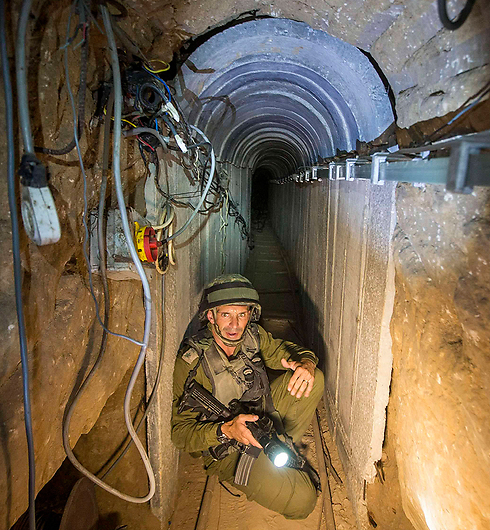
Photo: Associated Press
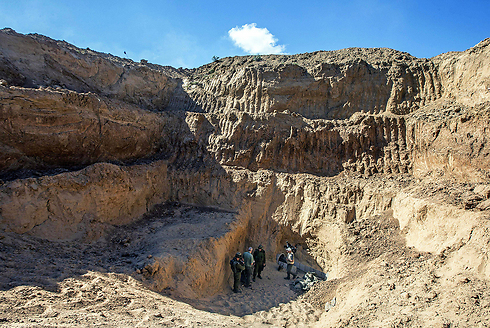
Entrance of a tunnel said to be used by Palestinian militants for cross-border attacks (Photo: Reuters)
The Gaza tunnel project is organized, calculated and does not leave any room for piracy. It is coordinated between all the factions' military wings and includes the registration of all the tunnels in the Strip, including the tunnels' routes, the ways to enter them and the destination according to which they are mapped.
The tunnels are divided into four districts: The northern Strip, Gaza
city, the central Strip and the southern Strip. There is one person in
charge of each district in coordination with the other districts, and
only one person in charge of each tunnel. In order to maintain the
secrecy, his name and the tunnel's route are kept confidential. The
diggers and the person in charge of the district are the only ones
familiar with the details.
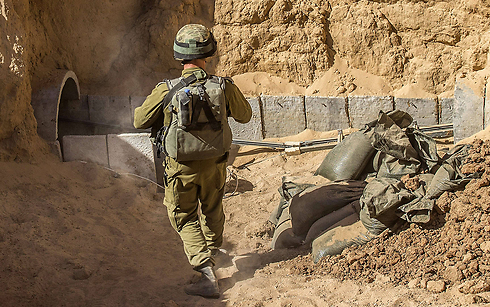
Photo: AFP
Each military wing in the Strip is permitted to dig a tunnel only after coordinating the activity with the person in charge of the district. An average dig takes about four months. Most of the tunnels are dug by hand during the night, and each tunnel is accurately calculated.
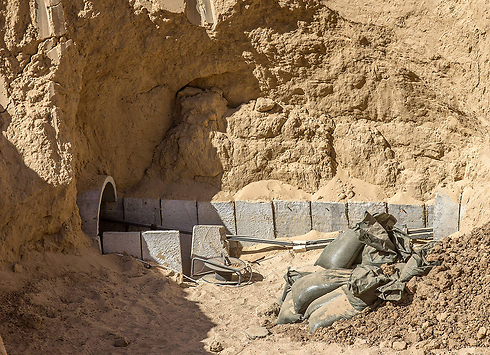
Photo: EPA
The factions have defined every part of the Strip as eligible for a tunnel for military purposes. When a tunnel is dug near the border fence, those responsible for it notify the land owner, subject to security coordination, and stress the structural separation:
Everything above the ground belongs to him and everything under the ground is under the responsibility of the military factions. If needed, he will be financially compensated. Thus, some of the land owners know that there is a tunnel under their lands, but they are unfamiliar with its route.
More:
 One of Israel's objectives is to destroy tunnels used by militants to stage cross-border attacks (BBC)
One of Israel's objectives is to destroy tunnels used by militants to stage cross-border attacks (BBC)Network of tunnels from Gaza to Israel at centre of latest war
Tia Goldenberg, The Associated Press
Published Friday, July 25, 2014 8:00AM EDT
Published Friday, July 25, 2014 8:00AM EDT
JERUSALEM -- A network of tunnels Palestinian militants have dug from
Gaza to Israel -- dubbed "lower Gaza" by the Israeli military -- is
taking centre stage in the latest war between Hamas and Israel.
Gaza's Hamas rulers view them as a military game changer in its conflict with Israel. The Israeli military says the tunnels pose a serious threat and that destroying the sophisticated underground network is a key objective of its invasion of Gaza.
Israel has known about the tunnels for several years, but has been hard-pressed to find an effective way to block them. Now it is counting on its ground war to at least reduce the threat.
Gaza's Hamas rulers view them as a military game changer in its conflict with Israel. The Israeli military says the tunnels pose a serious threat and that destroying the sophisticated underground network is a key objective of its invasion of Gaza.
Israel has known about the tunnels for several years, but has been hard-pressed to find an effective way to block them. Now it is counting on its ground war to at least reduce the threat.
"Israel knew there was a problem with the tunnels, but it didn't
internalize their significance," said Shlomo Brom, a retired Israeli
general. "At any given moment, Hamas could send dozens of militants
through separate tunnels to attack communities in Israel."
Gaza has two sets of tunnels -- those reaching Egypt and those reaching Israel.
The underground passages to Egypt are meant to bypass a border blockade
on Gaza that was tightened by Israel and Egypt after Hamas seized the
territory in 2007. The tunnels provide an economic lifeline and are used
to deliver building supplies, fuel, consumer goods and even cattle and
cars.
In some of those tunnels, Gaza militants received weapons and cash from
their patrons abroad, particularly Iran. Egypt has destroyed virtually
all of the tunnels over the past year, driving Hamas -- which was taxing
the smuggled imports -- into a severe financial crisis.
Separately, Hamas significantly expanded its network of tunnels from
Gaza to Israel after a major Israeli ground offensive that ended in
January 2009.
Several senior Hamas officials have told The Associated Press that the
expansion of those tunnels was part of a broader shift in military
tactics after 2009, with input from the Hezbollah guerrilla group in
Lebanon, which has fought Israel repeatedly.
"There are thousands of resistance fighters working underground and
thousands others working above the ground, to prepare for the upcoming
battle," Ismail Haniyeh, a top Hamas leader in Gaza, said earlier this
year. "No one can imagine what the resistance is ready to do to confront
the occupiers."
In addition to the tunnels, Hamas also boosted its arsenal of anti-tank
rockets, which had proven effective in Hezbollah's battle with Israeli
ground troops in Lebanon in 2006, said the officials, who spoke on
condition of anonymity because they were not permitted to discuss
military strategy with reporters.
Hamas also moved many of its rocket launching sites and storage sites
underground, making it more difficult for Israel to target them. Since
the current round of Israel-Hamas fighting began on July 8, Gaza
militants have fired more than 2,000 rockets at Israel and repeatedly
tried to sneak into Israel through tunnels.
Such attempts have stoked new calls in Israel to destroy the tunnels,
something that can only be done by ground forces. This helped rally
widespread public support for the Israeli invasion of Gaza, despite the
rising number of Palestinian deaths.
More than 800 Palestinians have been killed, three-fourths of them
civilians, and most since Israel's ground operation aimed at hitting the
tunnels began eight days ago, according to U.N. figures. Thirty-four
Israelis, including 32 soldiers, and a Thai worker have been killed.
Israel says Hamas has dug dozens of tunnels, linking them to each other
as well as to rocket manufacturing sites, maintenance facilities,
launch sites and command and control centres. It says the tunnels are
meant to facilitate mass attacks on Israelis as well as kidnappings, a
tactic that Hamas has used in the past.
In 2006, Palestinian militants burrowed under the border to an Israeli
army base, killed two soldiers and captured a third, Sgt. Gilad Schalit.
After being held captive in Gaza for more than five years, he was
exchanged for more than 1,000 Palestinian prisoners in 2011.
Soldiers have uncovered 31 tunnels in the current round of fighting, the military said Thursday.
Palestinian militants trying to sneak into Israel through the tunnels
have been found with tranquilizers and handcuffs, an indication that
they "intended to abduct Israelis," according to the military.
"Hamas has dug terrorist tunnels under hospitals, mosques, schools,
homes, to penetrate our territory, to kidnap and kill Israelis. Now, in
the face of such wanton terrorism, no country could sit idly by," Prime
Minister Benjamin Netanyahu told visiting U.N. Secretary-General Ban
Ki-moon this week.
Israelis countrywide have been granted a front-row seat to the rising
threat thanks to footage released by the Israeli military, which has
shown heavily armed militants, toting rocket-propelled grenades and
automatic weapons, lying low in the weeds as they are spotted by army
lookouts.
In some cases they have been forced back into the tunnels and in others
they have been killed in shootouts with Israeli forces or airstrikes.
While a number of troops have been killed in the altercations, militants
have not reached nearby communities.
The visuals have spooked the country and fueled public support for the
latest incursion, which is backed by a majority of Israelis.
Still, some Israelis have questioned how Israel, which has minimized
casualties and damage from Hamas' rocket threat with its Iron Dome
missile defence battery, has been unable to stanch the infiltrations.
Beyond the casualties, the incidents have led widespread road closures
and forced thousands of residents to lock themselves inside for safety.
Brom, an analyst at the Institute for National Security Studies
think-tank , said he expected a greater push in Israel following the war
to find a comprehensive remedy to the tunnel threat.
Atai Shelach, a former commander of the military's combat engineering
unit, Yahalom, said ground forces could inflict some damage and deter
Hamas, but that more is needed for the longer term.
Shelach said Israeli companies are working to find a defence against
the tunnels, but have not yet succeeded in developing an adequate
solution.
Ideas that have been floated in the past include digging a canal filled
with sewage along the border meant to thwart infiltrations, but the
task would be expensive and may not suit the sandy soil around Gaza. A
variety of technologies could help detect tunnel activity through
acoustic or seismographic readings, but none are foolproof.
"We need a game changer like Iron Dome," Shelach said. "It's not a
question of money or resources. It just needs to be made a national
priority."
Read more: http://www.ctvnews.ca/world/network-of-tunnels-from-gaza-to-israel-at-centre-of-latest-war-1.1931417#ixzz38eCH0d8W
One News Page
One News Page
How Hamas Is Using Its Network Of Gaza Tunnels
Transcript: How Hamas Is Using Its Network Of Gaza Tunnels
Some are hundreds of miles long and stretch from Gaza into Israel.Hamas claims to have infiltrated Israel through through a vast network of tunnels.(Via Israel Defense Forces / CC BY 2.0 ) The IDF has made destroying these passageways a top priority — releasing this video showing soldiers setting off explosives at the entrances.
For its part, Hamas released its own video to various media outlets showing its fighters moving through the tunnels beneath the Gaza Strip.
(Via
ITN ) On Saturday, militants dressed in Israeli army uniforms
sneaked across the border and killed two Israeli soldiers, which as The
Wall Street Journal notes, was “the worst blow to the Israeli
military on its side of the Gaza border in years.” The underground
channels provide Hamas with a significant advantage, as Israel fears
they can be used to infiltrate Israel and ambush civilians or soldiers.
According to NBC , the tunnels can be incredibly sophisticated.
“Some boast concrete walls and ceilings, electric lighting, radio
communications, sub-tunnels running off to the sides, and many are
replete with booby-traps in case Israeli forces enter them.” The
Palestinian militant group has been expanding its network of tunnels for
years.
As one Israeli military official told The New York
Times, “Actually there are two Gazas … One above ground and another
under the ground.” The tunnels made headlines in 2006 when Hamas used
one to cross the border and seize an Israeli soldier.
They held that soldier for five years before he was released in exchange for 1,000 jailed Palestinians.
(Via Al Jazeera , Israel Defense Forces / CC BY SA 2.0 ) In 2013, after Israel discovered this concrete tunnel, the military froze the imports of all building materials to Gaza.
(Via Euronews )
And in March of this year, the Israeli army claimed to have found the
longest ever Hamas tunnel — reaching more than 65 feet underground.
(Via The Telegraph ) Similar cross-border tunnels have been used to smuggle in goods from Egypt but most were shut down by Egypt’s new government as part of its crackdown on the Muslim Brotherhood, of which Hamas is considered an offshoot.
(Via Flickr / Marius Arnesen ) Vox reports Gaza residents often suffer the most from the closure of these tunnels.
“Ci vilians have a hard time accessing basic supplies, like medicines and construction material.
The Gaza economy is stifled, and unemployment is estimated to be over 40 percent.
The tunnels are the means Gazan civilians have to deal with it.
Between Israel and Egypt, they may be in rough shape.” Meanwhile, Israel has expanded its ground offensive.
A hospital spokesperson in Gaza told CNN an Israeli shelling of the town near Gaza City Sunday killed at least 40 people and wounded 300 others.



No comments:
Post a Comment